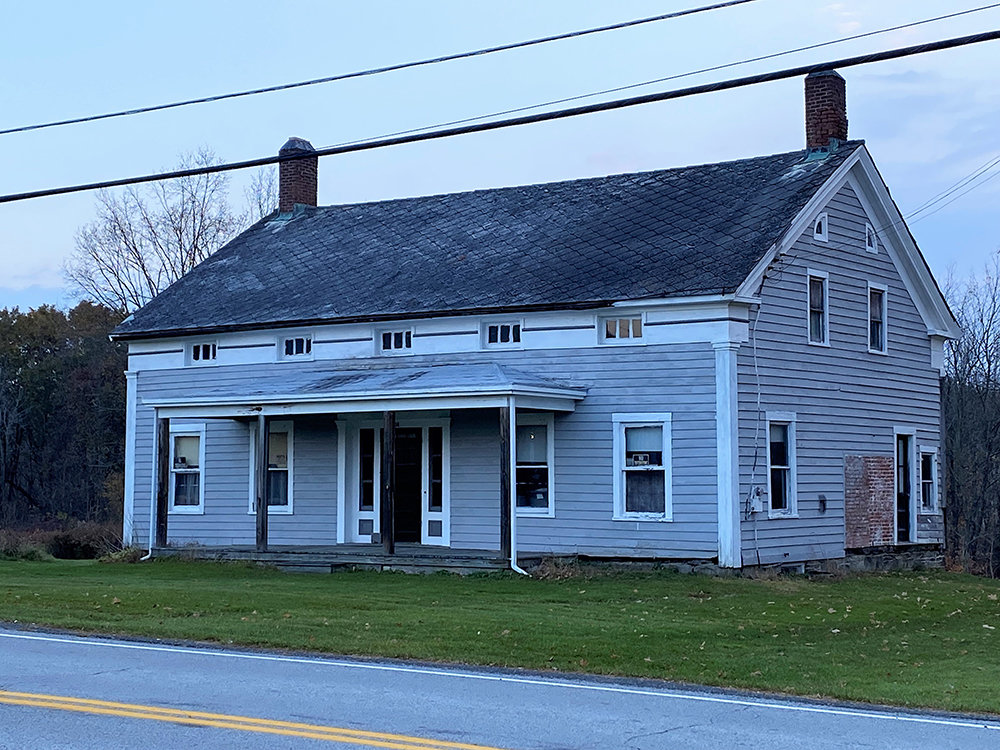
The Isaac Wood Homestead was built in 1800.
A while back, I began researching the old Wood homestead on Lakeside Road. I grew up knowing the couple living there, Alfred and Virginia Wood, and had even been inside a few times. Chatting with the one of the individuals who now owns it and maintaining it, he had a rough idea of the age of the structure, but no real documentation.
Going back to old maps of our Town, there is a map from 1936, titled Orange County Before 1810, which, though not precisely to scale with respect to location, shows many of the older homes and the year they were built, at least to the best of the cartographer’s knowledge at that time. Looking at this one, it’s seen the Isaac Wood Homestead was built in 1800. Imagine, well over 200 years old and still standing in good condition.
This makes a statement about the craftsmanship of those early pioneers who settled our community. Granted, repairs and upkeep has been done over the years, but probably up to maybe twenty years ago, there was still no indoor plumbing! I guess many of you will find this astounding, but one needs to remember, indoor plumbing only came into common use about 90 to 100 years ago. For those of you who have never used an outhouse, particularly in mid-January, you don’t know what you’re missing.
So, just who was Isaac Wood’s family? From previous research and records I discovered, I knew he was associated with the old cemetery on Lakeside Road which pretty much ceased to be used in the mid 1800’s. This cemetery was associated with the Baptist church which was there and was an offshoot of the Pleasant Valley Baptist Church. I’ve previously written about this tiny, hallowed ground, a memorial to some of our Town’s oldest settlers. I still continue to dig and unearth records of the church and cemetery which once existed there, but they are few and far between. Who knows? One day maybe more church records will surface.
Let’s drift back before 1800. Israel Wood, the son of Israel Wood, Earl of Warwick in England, accompanied the Duke of York to New York. At that time, Israel purchased a six mile square parcel from a man who had received a grant from the Holland Government, in the Township of Brookhaven, in what is now Long Island. He divided this parcel into farms and secured tenants for these farms while also marrying and settling there himself. Three sons were born to this union, the oldest was Israel, the next, Cornelius, and the youngest Alexander.
All three sons were successful, but for the purpose of the Wood Homestead, we need to focus on Cornelius and Alexander, who both eventually moved and settled here in 1761, in what would become the Town of Newburgh, purchasing a tract of land of 2,000 acres. The deed for this property was from King George the Third, of England. Cornelius married Sarah McCamley. The couple had four sons (Stephen, Cornelius II, John, and Gidney) and three daughters (Jane, Sarah, and Mary). Some of the highlights in Cornelius’s life were being elected one of the pathmasters in 1764, being a signer of the Revolutionary pledge, and serving in the Revolutionary militia.
Cornelius Wood was born in 1728, and passed away in 1798. He was buried in the Patton Burial Ground. When the Cochecton Turnpike was being built, at the turn of the century, after the company was formed in 1801, his resting place was found to be directly in the middle of the then new road. His remains were removed and reinterred by the wall on the south side of the turnpike. If you’re interested, the Patton Cemetery is on the knoll on the south side of State Route 17K, just east of the entrance road to the transfer station, and north of the old Orange County Choppers building. His wife, Sarah McCamley passed while visiting relatives in Binghamton and is buried there.
During the Revolutionary War, Cornelius served and was a member of the Exempt Company of Samuel Clark’s regular company of militia, Col. Hasbrouck’s Regiment, as noted by the rolls of April 30, 1778 and 1779. The men in the Exempt Company were those who had either passed the age of liability for military duty, or were in professional life as a physician or in previously military duty served as officers. They were regularly enrolled and liable for duty to repel invasions and suppress insurrections, and were specially assessed to supply men in their places in the ranks of active companies in connection with which they were enrolled.
Upon his death, in 1798, Cornelius bequeathed 150 acres of land “lying at the place called the Great Pond” to his son, Stephen. The Great Pond was the name given to Orange Lake back in the early days. Stephen Wood (b. 1760, d. 1834) married Lavina Sands (b. 1760, d. 1825), and, as the saying goes, the rest is history. On this parcel, the house was built, ready to be filled with the memories of so many of the Wood family yet to be born, and it continues to proudly stand till this day.
Stephen and Lavina’s grandson, Henry D. Wood (b. 1814, d. 1877), was more than likely the first generation to be born and raised in this home and on this land, and during his life, he continued to farm it as did his ancestors. He married Marinda W. Snyder (b. 1823, d. 1888).
If you’re exploring the genealogy of this family, many familiar names will appear including, but not limited to the Allisons, Belknaps, Cosmans, Dennistons, Gedneys, McCamleys, Morrisons, Pattons, and Sands. All these pioneer families settled this land and shaped it for us today. Perhaps if you’re driving by this old homestead, remember to say thanks to all we’ve been given from their hard work clearing the land and making our Town what it became.